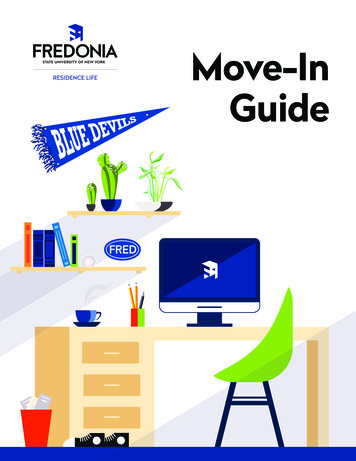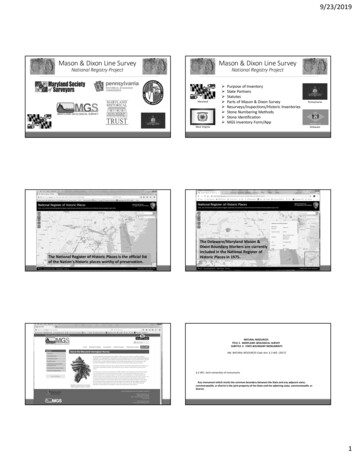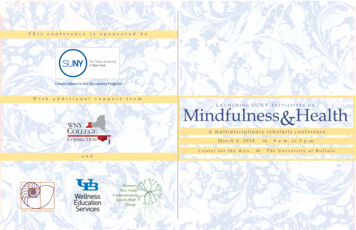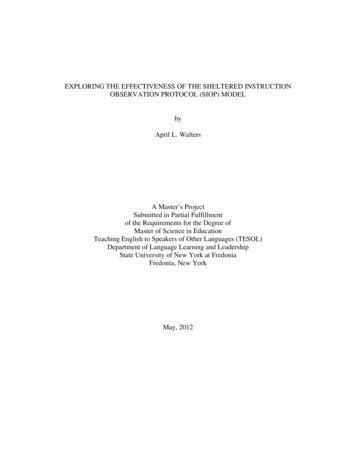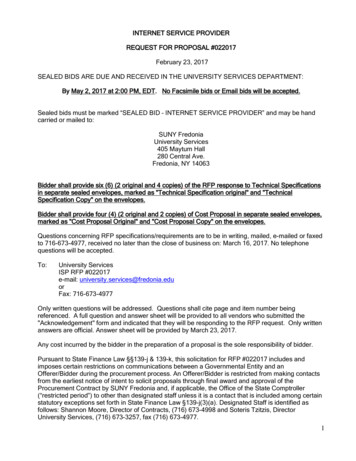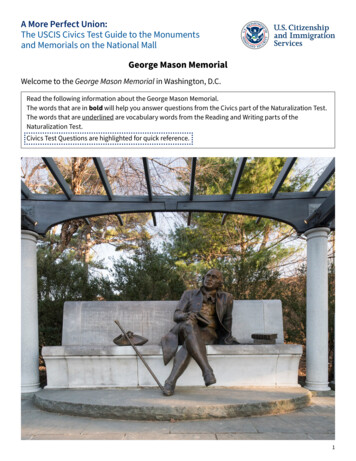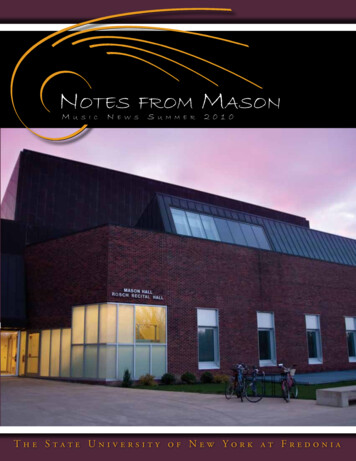
Transcription
Notes from MasonMu s i cNe w sSu m m e r2010T h e S t a t e U n i v e r s i t y o f N e w Y o r k a t F r e d o n i2 a
d i r e c t o rt h ef r o mDear Alumni & Friends,We publish our annual issue of Notes from Mason with excitementand pride. There is a lot to report: recent activities, upcoming activities,and faculty, student and alumni accomplishments. I hope you enjoy whatyou find within these pages and that you are as pleased as I am with theresults of our School of Music.During this past year, the existing rehearsal rooms in the Annex (1051and 1053) were mostly unavailable to us because of construction of newrehearsal rooms. To accommodate, we took all the seats out of Diers RecitalHall so we would have a large area with a flat floor. Amazingly, everyone gotthrough the experience with minimal complaint or consequence. Now wehave three rehearsal rooms on the north end of Mason (1051 plus the twonew rooms 1075 and 1080), and Diers Recital Hall received an attractivetreatment of refinished wood and historic paint colors, as well as new,comfortable seats.Since the beautiful Rosch Recital Hall opened in 2004, performance ingeneral has simply taken a higher profile in our students’ activities. Theopening night concert at NYSSMA in December provided a prime exampleof the performance skills that have developed at Fredonia. The WindEnsemble, Chamber Singers, College Symphony Orchestra, and the HillmanOpera were all part of this terrific, enthusiastically received showcase.The number of concerts, recitals and special events is too numerous to allowus to highlight them all in this publication. The back cover tells you how toregularly receive concert and event information, and you can always find thelatest information at the website.Toward the back of Notes from Mason, you’ll find the list of donors to theSchool of Music during the past year. We have made an effort to includethe names of people who gave to any fund that benefits the music programsor its students. Perhaps you’ll find your name on this list. If so, we areincluding you in the new designation the Friends of Music. No matter whyyou give, how often you give, and how much, donors such as yourselvesare vitally important to the well-being of the School of Music. We areaggressively working to advance our funds in the areas of scholarship, guestresidencies, ensemble tours, and musical instrument acquisition. Whenfacing increasing competition, higher costs, and compressed state funding,the need for your support is critical. Thanks for all you do for the School.It inspires us to perform well as we prepare students for successful careers inmusic.Karl Boelter, Directorin this issueMason Hall Grows with NewRehearsal Room Addition, p. 1Highly Anticipated2010-11 Events, p. 2Chamber Singers TourPuerto Rico, p. 3College of Visual and PerformingArts Planned for Fall 2012, p. 4Jazz at Fredonia Then and Now, p. 4Creating New Insightsinto New Music, p. 5Fredonia and Potsdam Perform JointPerformance at NYSSMA, p. 6New directions in the Western NewYork Chamber Orchestra, p. 6Chautauqua Children’s Chorale WelcomesNew Alumni Leadership, p. 7Musical Journeys Program offers new“Pathways to Music,” p. 7Faculty News & Highlights, p. 8Alumni News, p. 12Scholarships and Awards, p. 14News from the FredoniaCollege Foundation, p. 15Friends of Music, p. 16Notes from Mason is published by the School of Music once a year. We welcome your suggestions and submissions of articles, alumninews updates, and photos. Please e-mail information to Lori Deemer, lori.deemer@fredonia.edu, or send by mail to: Notes from Mason, Schoolof Music-Mason Hall, SUNY Fredonia, Fredonia, NY 14063.iDesign and Photography: Lori Deemer
Mason Hall Grows, Moves Closer to Rockefeller Arts Center, withNew Rehearsal Room AdditionYYears ago, there was a lot of space between buildings on theFredonia campus. They seem to have grown together, andMason Hall and Rockefeller Arts Center are a case in point.rehearsal spaces. They were designed and built specifically toaccommodate the larger band and orchestra groups, whichhave grown to as many as 120 members.The north wall of the original Mason Hall completed in 1941and known affectionately as “Old Mason” is about 350 feetfrom the south wall of Rockefeller Arts Center (completed in1968)—more than a football field in distance. The first MasonHall addition was the Mason Annex, completed in 1961,reducing that distance considerably. After “New Mason”was added in 1972, expanding the building to the west, thedistance between Mason and Rockefeller settled at about 125feet—a distance any instrument-carrying student will tell youis still trouble for a rehearsal in King Concert Hall in snowand a cold wind.The need for the new rooms was demanded in part by newbuilding codes that established an occupancy limit of 40 forexisting rooms 1051 and 1053. For rehearsals, the ensemblescrammed into the spaces, and each year it was becoming agreater challenge. As the ensembles became bigger and moreconfident, another issue also evolved. The sound created in therooms was more than the spaces could handle. The solutionwas not an acoustical treatment – the rooms were simply notlarge enough.With the opening of the new rehearsal room wing latesummer 2010, only 40 feet will remain. The next buildingphase (which is bound to happen in the years ahead)will actually combine the two structures, finally unifyingperformance, storage, and support facilities for all the arts atFredonia.For now, though, we celebrate the two new rehearsalrooms, each two to three times the size of any of our priorRoom 1075, the smaller of the two new rooms, is 50 feet by50 feet. Room 1080 is almost 50 percent larger than that, at60 by 70 feet. The existing room 1051, a mere 1,600 squarefeet, will remain an excellent rehearsal room for smallerensembles. Room 1053 is being divided up for storage andsupport, including a small rehearsal space.The addition was designed by Foit-Albert Associates and builtby SLR Construction, both of Buffalo, N.Y.1
Combining the talents of instrumental and vocal students withfaculty and alumni soloists including soprano Barbara Kilduff (’81),faculty member and mezzo-soprano Laurie Tramuta (’82), tenor AlanSchneider, and baritone Erik Angerhofer (’02) under the direction ofDr. David Rudge, the April Masterworks Scholarship Benefit Concertfeatured Beethoven’s Symphony No. 9 and raised 7,000 in funds for theSchool of Music Scholarship Endowment!Highly Anticipated Events of the 2010-2011 SeasonFor ticket information, please visit www.fredonia.edu/tickets or call the School of Music, (716) 673-3151.Robert Jordan, PianoA CelebrationSaturday, September 11, 2010 at 4:00 p.m.Rosch Recital HallHoliday Concert for the Campus and CommunityBach Cantatas with the College ChoirGerald Gray, conductorWednesday, December 8, 2010 at 7:30 p.m.Rosch Recital HallThe School of Music is honored to host a celebration in honorof esteemed emeritus piano professor Robert Jordan on his70th birthday. The event includes a concert, reception anddinner, and is highlighted by the announcement of a splendid,new endowment in his name made possible by one of hisappreciative students, with additional contributions frommany, many others.The Holiday Concert program includes four cantatas by J.S.Bach (BWV 131, BWV 62, BWV 133, and BWV 72) andfeatures eighteen orchestral players, four soloists, and the fortymembers of the Fredonia College Choir. Baroque specialistsfrom all over the United States and Canada comprise theprofessional orchestra for this special event.Robert Jordan joined the faculty in 1980 and retired in 2004.With degrees from the Eastman School and the JuilliardSchool, he has appeared with orchestras in New York City,around the United States and in Europe. He is a FulbrightScholar and a recipient of the Kasling Award.Jordan’s recital will feature works by Bach-Busoni, D. Scarlatti,Chopin, Debussy and Liszt. Tickets will be available for theconcert only, or packaged for the entire event.2“I chose this particular repertoire for artistic and programmaticreasons,” said professor Gray. “These four cantatas provide agreat shape to the event, bringing us from relative darknessand despair into the pure joy of the Savior’s birth. These arevery expressive contrasting cantatas that make for a vibrant andmoving concert experience.”The Holiday Concert originated as a one-time event with aperformance of Handel’s Messiah in Rosch Recital Hall. Itquickly gained momentum as an annual event because ofits unique musical approach to the Baroque period, and theexcitement generated by the quality of the soloists, orchestraand choir. The repertoire rotates each year between Handel’smasterpiece and other works for chorus and orchestra that areappropriate to the season. Dr. Gray added, “I’m pleased thatthe event has become a first-rate musical experience for somany people in our community.”
Chamber Singers Tour Puerto RicoScholarship Benefit ConcertCollege Symphony Orchestra with Masterworks ChorusDavid Rudge, conductorSunday, April 17, 2011 at 4:00 p.m.King Concert HallThis annual event of the College Symphony Orchestraand Masterworks Chorus is a musical highlight of the yeardue to the quality of the music-making, the insightfulprogramming, and the number of participants on stage. Theevent is also intended to bring awareness to the need forscholarship resources at Fredonia. After only its second year,the Scholarship Benefit Concert has already added more than 14,000 to the music scholarship endowment.This April’s program will feature Hector Berlioz’s Overtureto Benvenuto Cellini for orchestra alone, Claude Debussy’sThree Nocturnes with off-stage women’s chorus, and MauriceDuruflé’s beautiful Requiem, featuring professor LynneMcMurtry as the mezzo soprano soloist.“I anticipate audiences will truly fall in love with thisprogram,” said Director of Orchestras David Rudge. “TheBerlioz is a flashy, brilliant, high-energy overture that willbuild excitement for the rest of the program. Of course, theDebussy offers gorgeous French impressionistic music. Thetrue masterpiece of the evening, however, is the Duruflé. Thisrequiem mass, based on early plainchant, is enchantinglybeautiful and comforting. Together, this will be a memorableevening for everyone.”TThe Fredonia ChamberSingers under thedirection of Dr. DonaldP. Lang toured PuertoRico during January,which includedperformances at AteneoPuertorriqueno, theprestigious concerthall in San Juan, theConservatory of Musicin San Juan, as well asvenues in Ponce, Humacao, Adjuntas, and the island of Culebra.Junior music education major Eduardo Ramos, whose hometownis Ponce, helped to arrange home-stays with family membersand close friends and organize many details of the trip. “Ourfondest memories of the tour were of the people, who hosted usso graciously and generously,” offered Lang. “Our audiences wereenthusiastic at every venue. Everyone in Puerto Rico, it seems,sings well, plays guitar, piano, or another instrument. All of usmarveled at how deeply music seems to enrich the lives of thepeople in every household we visited.”The group performed at a memorial service in the Cathedral ofPonce to raise funds for the earthquake recovery effort in Haiti.The Cathedral was packed and the service was televised, with theMayor of Ponce and the Governor of Puerto Rico in attendance.Another highlight was a choral workshop with the Children’sChoir of Ponce, which is directed by Eduardo’s mother, MariaInez Ramos.3
College of Visual and Performing Arts planned for Fall 2012OOn February 19, 2010 Academic Affairs at SUNYFredonia approved a two-year transition plan that willculminate with the creation of a new professional arts unit– the College of Visual and Performing Arts.The decision is the result of a process that began latein Fall Semester, 2009 after Dr. David Ewing, Dean ofthe College of Natural and Social Sciences, accepted aposition as Dean of the College of Arts and Sciences atCanisius College in Buffalo. Vice President for AcademicAffairs Virginia Horvath called a campus-wide meeting onJanuary 22 to suggest that this might be an opportunityto restructure, and one of the options presented was aCollege of Visual and Performing Arts. The session wasfollowed by a series of meetings by the Senate and itssub-committees to discuss the merits of ideas as theysurfaced and developed. When Dr. Horvath announcedthe decision on February 19, she said that the final planwas shaped in many different ways and by many hands.“The process has demonstrated that any idea or proposal ismade that much stronger when many voices have workedtogether to articulate it,” Dr. Horvath said.On June 1, 2010, Dr. John Kijinski became the dean ofa new College of Arts and Sciences, which combines theformer College of Natural and Social Sciences with theCollege of Arts and Humanities, for which Dr. Kijinskihad been serving as dean. Groundwork will beginleading to the establishment of the College of Visual andPerforming Arts with a nationwide search in 2011-2012for a dean to be in place in the fall of 2012. The Collegeof Arts and Sciences will continue after the professionalarts unit is created.The College of Visual and Performing Arts will includethe School of Music, the Department of Visual Art andNew Media, and the Department Theatre and Dance.Unifying these arts programs within one college will helpdistinguish Fredonia in the SUNY system. “The arts atFredonia have pockets of true excellence and appeal ona national scale. The university has the opportunity tobring focus to this aspect of who we are, and to allowthe strengths to spread throughout our programs,” saidDr. Karl Boelter, Director of the School of Music. Dr.Boelter believes that, with vision and planning, all of its4programs will unify in recruitment strategies, fundraisinggoals, clarity of objectives, projects with high visibility,improved collaboration and overall branding initiatives.The new college will serve over 1,100 majors in a broadrange of undergraduate and graduate professional artsprograms, representing more than 20 percent of theuniversity’s student body.Support for a College of Visual and Performing Arts wasnot limited to those in arts fields but from those in otherunits who maintained that such a structure is aligned withSUNY Fredonia’s history, strengths and reputation. Thedecisions made for restructuring Academic Affairs havebeen collaborative, Horvath said, giving her confidencethat the end result will be an even stronger and morehighly regarded institution.Jazz at Fredonia Then and NowThe roots of jazz at Fredonia date from the early 1930swith an extracurricular dance band and the formationof a student organization, the Fredonia Jazz Workshop(FJW). Over the years, their big band performed infestivals at Notre Dame, Vancouver, Oakland andToronto, won numerous awards, and produced more thantwenty recordings. Through the decades of this studentorganization, Fredonia graduated many of the country’scurrent jazz musicians and educators and built a reputationas a significant campus forjazz. “A great strength over
Creating New Insights into New MusicOThrough the efforts the composition faculty andthe Ethos New Music Society student organization,there were an unprecedented number of concerts,lectures, workshops and master classes throughoutthe school year by guest composers and performersas well as several concerts that featured the worksof student composers.The 10th anniversary season of the NewSoundFestival was comprised of five concerts representinga wide variety of musical styles and experiences,including appearances by the Rascher SaxophoneQuartet, composers Paul Moravec, GeorgeTsontakis, Alexandra Gardner, Steven Bryantand Jonathan Newman, and a special eventwith Fredonia’s Wind Ensemble. The programwith the Rascher Saxophone Quartet includedcollaborations with saxophone professor WildyZumwalt and the Fredonia Chamber Singers, and anew work by professor Rob Deemer commissionedby the quartet. Paul Moravec (Pulitzer 2004) heardsong cycles and the first concert performance ofexcerpts of his new opera, The Letter, performedby SUNY Fredonia voice faculty, and GeorgeTsontakis (Grawemeyer 2005) was treated toperformances of his works by a pianist HilaryDemske and the Fredonia Woodwind Quintet.All composers and performers on these programsalso participated in lectures and workshops in theSchool of Music and provided master classes orlessons with student composers.Six additional concerts were offered in a seriescalled “Ethos Presents ” Intended as anenhancement to the NewSound Festival, this seriesprovides a broader range of new music performersand interpreters. The series featured pianist DannyHolt, guitar duo Modal Kombat with professorEvan Drummond, violinist Cornelius Dufallo,pianist Rob Auler, mezzo soprano Clara O’Brienand emeritus professor Donald Bohlen.Ethos also invited emerging composers from acrossthe country to come to the School of Music topresent lectures on their music and other topics oftheir choice. These events, called the “OvernightComposers” series, included Rafael Hernandez,Armando Bayolo, Brian Current and Jenny OliviaJohnson.The composition program, under the leadershipof Rob Deemer, strives to give student composersa wide spectrum of opportunities to write musicand have works performed. Ethos organized andpresented four student composer concerts, thePercussion Guild at Fredonia presented an eveningof student work, and the dance program matchedcomposers with choreographers for a program ofcollaborations. Both the Wind Ensemble andthe College Symphony gave reading sessions ofsubmitted work for large ensembles.the years has been that over half of the music they performedwas either written by one of the members or arranged by them,”said professor Linda Phillips, who helps to organize the annualreunion band that performs at Homecoming Weekend. Theprofessional abilities and leadership in the alumni groups are veryhigh, which is a testament to the kind of musician FJW attractedand produced throughout its existence.A year ago, FJW unveiled a new recording – the first in 16 years –titled “The Fredonia Jazz Ensemble: Still Kickin’.” Matt Koerner,co-leader of the current group, said, “As we were preparing to dothe new CD, we contacted alumni and asked questions abouthow to do this, what it was like for them, andwas it a good idea. Before we knew it, we had aFacebook forum and a whole network of peoplevolunteering their time and talents. We receivedunwavering support from all corners of WesternNew York and all the way out to Los Angeles.”Nine years ago, in order to meet the demand forjazz instruction within the School of Music, BruceJohnstone was hired to lead a curricular program of jazz trainingand performance. Mr. Johnstone, a native of New Zealandand an alumnus of the Maynard Ferguson Big Band, was livingin Western New York and was eager to accept the challenge.The School of Music Director Karl Boelter has had severalconversations with Johnstone about the goals and the challenges.“We didn’t want to replace FJW,” said Boelter. “Instead, wewanted to create a place for innovation, education, and experiencewith the full range of what jazz is.”Johnstone has been very successful with meeting the challenges.He is highly respected by the students, and FJW asked that heserve as their faculty adviser three years ago, which he continuesto do and enjoy. Most of the students in FJW are now musicmajors, and many of these same students populate the curricularbig bands and combos. The door is not closed for anybody, soinitiatives have resulted in opportunities for vocal soloists, jazzvocal groups, strings and unusual instrumental combinations.Johnstone added, “At some point Fredonia should put on a jazzfestival. We currently have five fully stocked big bands and sevensmall groups. The interest in jazz is higher than it has ever been.”5
Fredonia and Potsdam Perform JointConcert at Winter NYSSMA ConferenceNew Directions in the Western New YorkChamber OrchestraLast December’s New York State School Music Association(NYSSMA) Winter Conference proved to be a delightfulexperience for all of SUNY Fredonia’s faculty and students.Held in Rochester, New York, on December 3, SUNYFredonia’s School of Music and SUNY Potsdam’s Crane Schoolof Music students came together for an epic joint concert thatstudents from neither school will soon forget. For Fredonia’spart, the program included segments by the Wind Ensemble,Chamber Singers, Hillman Opera (La Bohème) and the CollegeSymphony Orchestra.The Western New York Chamber Orchestra (WNYCO) isa fully professional orchestra for the Fredonia communityand is an ensemble-in-residence with the School of Music.The group started 27 years ago as the Fredonia ChamberPlayers, and it has grown and evolved over the years underthe leadership of Jay East, then professor of clarinet, as theorganization’s executive director. Mr. East retired fromthe faculty two years ago and has now decided to pass thebaton, so to speak, on this role as well. Bassoon professorLaura Koepke and her husband Jordan Frazier will becomeco-directors of the organization and are very excited aboutshaping its future. Both Laura and Jordan have extensiveexperience with professional music organizations, perhapsmost significantly as long-standing members of the OrpheusChamber Ensemble of New York City. In taking on theposition, they desire to emphasize certain key factors aspriorities, such as continued pursuit of musical excellence,joint partnership with the School of Music, and relevance tothe communities of Western New York.Professor David Rudge, Director of Orchestras, mentionedthat “the students were a little stunned when I announced inthe preceding spring semester that both schools were going tobe on the same program. When the students came back in thefall semester, they were highly motivated to do their absolutebest. Personally, I too felt a very big responsibility to them andto the School of Music as a whole. The students placed a lot oftrust in me to prepare them very carefully and to make sure theperformance was as polished as it could be. In turn, there wasa lot of serious preparation and cooperation on their part. Thatwas very gratifying.”Professor Donald Lang, director of the Chamber Singers,added, “At the dinner before the concert, when the studentsfrom both schools had a chance to mingle, I made it a pointto sit with some students from Potsdam. We shared a livelyconversation and had a good time.”Professor Paula Holcomb, Director of Bands, also enjoyedseeing the interaction of the schools. “Many students kneweach other from their public school settings so it was neat tosee old friends hug and reunite. We actually have identicaltwins attending the two different schools. Kelsey Lamb is apercussionist in the SUNY Fredonia Wind Ensemble andKendra Lamb is a member of the French horn section atCrane! How cool is that!”The opening concert performance is usually given by a speciallyinvited performer or speaker. “It goes without saying that theeyes and ears of some very critical music professionals were onus, and the response was overwhelmingly positive,” noted Dr.Rudge.6The CollegeSymphony Orchestra at the NYSSMAWinter Conference opening concert.School of Music Director Karl Boelter said, “Having Lauraand Jordan step up to leadership roles with WNYCO seemsto me to be a point of potential reinvention for the group. Itwill be delightful to see what will come from their uniqueinsights. We have established a team of people from theSchool of Music and the WNYCO board to see how we canfacilitate possible new directions.”Also changing roles is President of the Board of Directors.School of Music voice faculty member, Julie Newell, endedher term after seven years. She is replaced by Mr. SandyRotunda, a Fredonia native and businessman, who has a longfamily heritage with the School of Music. Sandy’s mother andtwo sisters are also School of Music alumni.WNYCO has performed well over a hundred concerts inits history, and many of them have featured notable worldrenowned artists, including recent appearances by composerPeter Schickele and guitarist Sharon Isbin. Last spring,perhaps as a hint of things to come, the orchestra collaboratedin very well-received performances of Benjamin Britten’sopera The Turn of the Screw, which featured a cast of facultyand student singers from the School of Music.
Chautauqua Children’s Chorale WelcomesNew Alumni LeadershipThe Chautauqua Children’s Chorale, one of Fredonia School ofMusic’s ensembles-in-residence, was founded in 1988 by NancyKrestic and Professor Donald Lang. The organization has flourished,performing several concerts each year, appearing with the BuffaloPhilharmonic, collaborating with productions at the School of Music,commissioning works by prominent composers and touring annually.“The Chorale has had the opportunity to sing in children’s choirfestivals in different parts of the world — finding out that youngpeople who love to sing will always have something in common,” saysMs. Krestic. “They have experienced the world in song.”Krestic, who has been the conductor of the Concert Chorale since itsinception, and Daniel Bromsted, the conductor of the Junior Chorale,both retired at the end of the 2009-10 concert season. Marjorie Bohnand Brad Carson, who are graduates of the School of Music andcurrent educators in the public schools of Western New York, havebeen selected by the Board of Directors to shape the future of theorganization. Mr. Carson held an internship with the Chorale whilea School of Music student; Ms. Bohn has a long relationship with thegroup and was one of its original members.It isn’t hard to find evidence of the group’s significant impact on itsparticipants, such as in this essay written as a school assignment by JillMagara, a current choir member from Salamanca.My choir is called the Chautauqua Children’s Chorale. Iheard about this professional choir through my voice teacher,Kathy Black, because one of her former students used to bein it, and she loved it, and Ms. Kathy thought I would loveit too. And I do! We scheduled an audition and went tothe director’s house and I tried out. The choir is pretty big,consisting of about sixty kids that are split into two choirs. Mygroup, the Concert Chorale, has about thirty-five membersfrom places like Gowanda, Silver Creek and Fredonia. I amthe farthest away from rehearsals, and they think that it’sweird that I would drive all that way, but there isn’t a grouplike it where I live. All the kids in my choir are really cool.We all share the same interests and like to do the same things.Plus, all of us are smart.The schedule for my choir is extremely tight, strict and busy.You are expected to be at all rehearsals, which are everyTuesday from 6-8 p.m., and every other Saturday from 10noon. All rehearsals are held at the Fredonia School of Music,which is a long drive for me. On the way back every Tuesday,my mother makes me listen to the talk show Delilah. I hateit, but my mom thinks I will have fond memories of it whenI am older.During the year, we have about 12 shows. Some are withother choirs and then some are by ourselves. Any money wemake goes into the trip fund and is distributed evenly betweenall of the kids going on the summer trip. And yes, we makemoney because we are a professional choir. We have around50-60 pieces of music to memorize and know all year long.It is extremely hard and brain-consuming. We are taking aneight day trip to Nashville to sing at the Grand Ole Opry thissummer. I am pumped! Now you know a major part of mylife. This helps make me who I am.The Musical Journeys Program of the Fredonia School ofMusic is proud to announce an exciting new program forchildren and parents to discover the joys of experiencingmusic while singing, moving, listening, dancing, and playing.Pathways to Music is designed for children ages 6 monthsthrough 5 years old.Each class is a combination of age-appropriate musical activitiesincluding songs, finger plays, dances, bouncing games, circlegames, instrument exploration, lullabies and more. In a playfulmanner, children will be gaining a wide appreciation of musicwhile developing language, motor, creative and social skills.The once a week, 45-minute classes are for one child andone accompanying parent or guardian. Three classes will beoffered this fall. Pioneers, for ages 6 to 24 months, will meeton Saturdays at 9:30 a.m. Explorers, for 2 and 3 year olds, willmeet on Saturdays at 10:30 a.m. Adventurers, for 4 and 5 yearolds, will meet on Thursdays at 6:15 p.m. Total cost for the 10week course is 125. Beginning the week of September 23, allclasses will be held at 2140 Mason Hall.The curriculum used for Pathways to Music is a holisticapproach to age-specific early childhood music education,modeled after “First Steps in Music” by Dr. John Feierabend ofthe University of Hartford. Faculty members for Pathways toMusic have their own extensive training and experience to addto the program. Sonja Inglefield holds a master’s degree in EarlyChildhood Music Pedagogy from the Peabody Conservatory inBaltimore, Maryland. She spent almost ten years teaching earlychildhood music on the Peabody Preparatory faculty and in theBaltimore City Schools before moving to western New York.Kay Barlow holds Level 1 Certification from the Center forMusic and Young Children and the American Orff-SchulwerkAssociation, in addition to Master of Music and Bachelor ofMusic Education degrees. She was a recipient of the 2005Chautauqua County Early Childhood Award for Excellence inteaching.“In Pathways to Music, children are encouraged to explorecreative expression,” says Ms. Inglefield. “Every year, there ismore and more research confirming the positive influence ofmusic and movement on the healthy development of children.Even a very young child can benefit from the stimulation o
College Symphony Orchestra with Masterworks Chorus David Rudge, conductor Sunday, April 17, 2011 at 4:00 p.m. King Concert Hall This annual event of the College Symphony Orchestra and Masterworks Chorus is a musical highlight of the year due to the quality of the music-making, the insightful programming, and the number of participants on stage. The
